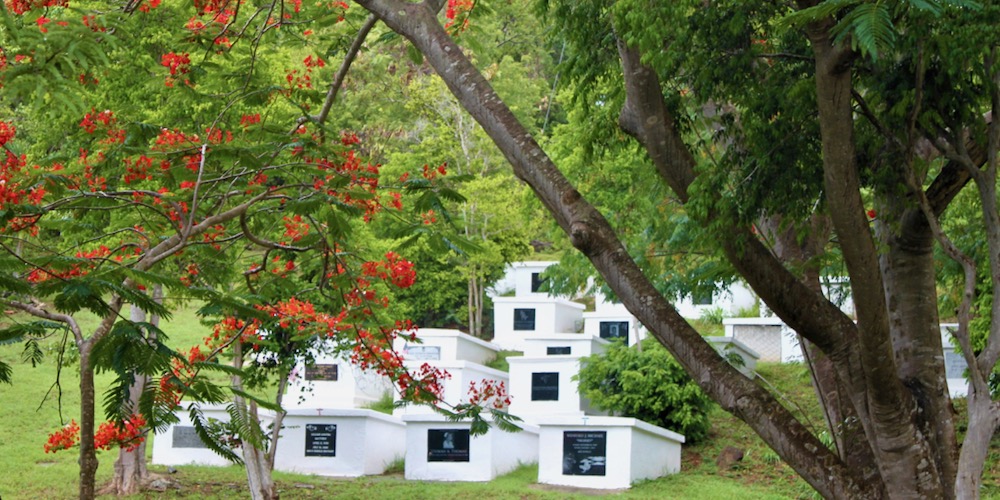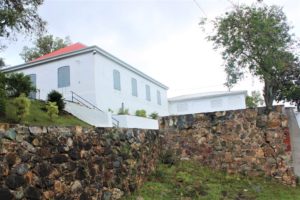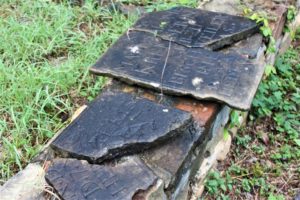
This is the third of three articles on the historic cemeteries of St. Thomas in the U.S. Virgin Islands. Excluding small family graveyards, there are eight cemeteries on St. Thomas, of which two are public and five are affiliated with religious groups. This article looks at Moravian burial places on St. Thomas. Previous stories looked at the St. Thomas Danish cemetery and the St. Thomas Jewish cemetery.
The Moravian Churches have a unique history in the U.S. Virgin Islands dating back to the early 1700s and are host to the most abundant burial sites on St. Thomas – two intimate church graveyards and two cemeteries.
But to understand anything about these burial sites, the church itself and the first Moravians must be understood.
Early records from the National Park Service’s National Register of Historic Places say the Moravians began their missionary work in 1732 and were the first of the religious groups in the Danish West Indies to establish active missionary work with those who were enslaved.
“The role assumed by the Moravians was to provide for the well-being of the slave through religion and education. The Moravian missionaries are credited with providing the foundation upon which emerging Black social patterns in the Danish colonies were established, specifically, the active participation of white religious groups in providing and establishing religious guidance and education for the slave,” a researcher says in a 1977 NPS nomination to put the churches onto the National Register of Historic Places. The form was prepared by Annie Hillary, Russel Wright and Philip Lader.
New Herrnhut Moravian Church was purchased in August 1737 but was only land at the time. Soon after, the first Moravian Church, or mission, on the island of St. Thomas was built.
“Frederick Martin, a Moravian missionary, purchased from a Mrs. Solomons a plantation on the east end of St. Thomas. Prior to being named New Herrnhut, after the mother church in Germany, the mission had been called The Brethren’s Plantation, The Brethren’s Tutu and Posaunenberg,” the records indicate.
By 1770, records show that New Herrnhut was a thriving plantation with a robust population of the enslaved that served as both “labor for the plantation and the congregation for the mission.”
What made New Herrnhut unique for the time was the dedication to educating the enslaved, who were given a formal education and religious instruction, something other plantation owners unsuccessfully sought to end.

The current pastor of New Herrnhut Moravian Church is Rev. Kirk Barker, who holds the key to the church’s burial records. A historic graveyard, that is site to multiple family generations, rests 400 feet south from the island’s oldest Moravian Church.
Barker said the graveyard is maintained by the New Herrnhut Moravian Church through paid and volunteer services, and the oldest grave “for which we found records is 1773, but that was burial plot number 24, so the assumption is there are 23 burials predating that.”
The quiet graveyard is nested in a grassy knoll with large flamboyant trees that rain down red flowers onto the traditionally white-painted crypts.
To be buried within, Barker said, “You have to be a Moravian in good standing.” As the reverend, he would lead the funeral processions, which traditionally consist of “opening sentences taken from scripture used at every funeral and set prayers at the internment.”
But New Herrnhut is not the only mission that has maintained its roots and is still a church today. Estate Nisky, the location of Nisky Moravian Church, is also on the National Park Service’s National Register of Historic Places.
“Estate Nisky, a working plantation, was purchased by the Moravians in 1755 to supplement its mission at New Herrnhut in the eastern section of St. Thomas. The estate continued in use as a plantation through the early part of the 19th century,” the 1977 nomination form says.

Martin, who made the Herrnhut purchase, “was responsible for establishing the mission on solid foundations during his 1736-1750 ministry. He sought to make the mission as self-supporting as possible by the purchase and development of plantations. By operating these, the Moravians ensured themselves of a livelihood and made pastoral work easier.”
Augustus Gottlieb Spangenberg, who joined the colony in 1733 and was appointed by the leader of the Moravian movement Count Zinzendorf, delivered the first sermon at Estate Nisky standing under a cottonwood tree.
Records show that Spangenberg went on to establish missions throughout the Caribbean, in Georgia, Pennsylvania and North Carolina. To further his pursuit, records also note that he founded the “Society for the Furtherance of the Gospel” in England.
While Nisky Moravian Church also has its own graveyard, there are two additional burial sites not located on church grounds.
“Memorial has a cemetery, but it is not on the church compound,” said Cortroy Jarvis, pastor of Memorial Moravian.
Instead, the church’s burial site sits side by side with the Danish cemetery on the western side of the Lionel Richards Stadium.
“There have been approximately 500 burials in the cemetery over the past 138 years,” Jarvis said.
The limited remaining space within the cemetery is reserved for Moravians. Non-members are buried at either the western or eastern public cemeteries, Jarvis said.
Guests visiting the site would see examples of multiple generations of families that have been buried there.
As the pastor for Memorial, Jarvis said he generally conducts the funeral services and is sometimes assisted by other clergy.
Jarvis said traditional burial practices are performed.
“We do have a brief ceremony that we do. It includes Words of Comfort, scripture reading and prayers,” he said. “In addition, before the casket is laid in the tomb and sealed off, the pastor would sprinkle some dirt on the casket and then says, ‘Earth to Earth, dust to dust, ash to ash.’ Songs would then be sung until the cemetery workers complete the work of covering and sealing the tomb.”
After procuring New Herrnhut the Moravian Church spread to other Caribbean islands: St. Croix in 1734, St. John in 1741, Antigua in 1756, Barbados in 1765, St. Kitts in 1777 and Tobago in 1790.
More information about the history of the Moravian Church is online at the Moravian Board of World Mission website.





